fuses CHEVROLET MONTE CARLO 2004 Owners Manual
[x] Cancel search | Manufacturer: CHEVROLET, Model Year: 2004, Model line: MONTE CARLO, Model: CHEVROLET MONTE CARLO 2004Pages: 416, PDF Size: 4.56 MB
Page 80 of 416

Arming with the Remote Keyless Entry
Transmitter
Your alarm system will arm when you use your remote
keyless entry transmitter to lock the doors, if the key
is not in the ignition. The light on the radio will turn on to
let you know the system is arming. After all doors and
the trunk are closed and locked, the light on the
radio will begin �ashing at a very slow rate to let you
know the system is armed.
Disarming with the Remote Keyless
Entry Transmitter
Your alarm system will disarm when you use your
remote keyless entry transmitter to unlock the doors.
The light on the radio will go off to let you know
the system is no longer armed.
The �rst time a remote UNLOCK command is received,
three �ashes will be seen and three horn chirps
heard to indicate an alarm condition has occurred since
last arming.
Disarming with Your Key
Your alarm system will disarm when you use your key
to unlock the doors. The light on the radio will go
off to let you know the system is no longer armed.
Passlock®
Your vehicle is equipped with the Passlock®
theft-deterrent system.
Passlock
®is a passive theft-deterrent system. Passlock®
enables fuel if the ignition lock cylinder is turned with
a valid key. If a correct key is not used or the ignition
lock cylinder is tampered with, fuel is disabled and
the engine will not start.
During normal operation, the SECURITY message will
be displayed after the key is turned to the ON ignition
position. SeeSecurity Message on page 3-48.
If the engine stalls and the SECURITY message
�ashes, wait until the light stops �ashing before trying to
restart the engine.
If the engine is running and the SECURITY message
comes on, you will be able to restart the engine if
you turn the engine off. However, your Passlock
®
system is not working properly and must be serviced by
your dealer. Your vehicle is not protected by Passlock®
at this time. You may also want to check the fuse.
SeeFuses and Circuit Breakers on page 5-104. See your
dealer for service.
In an emergency, contact Chevrolet Roadside
Assistance. SeeRoadside Assistance Program on
page 7-6for more information.
2-16
Page 119 of 416
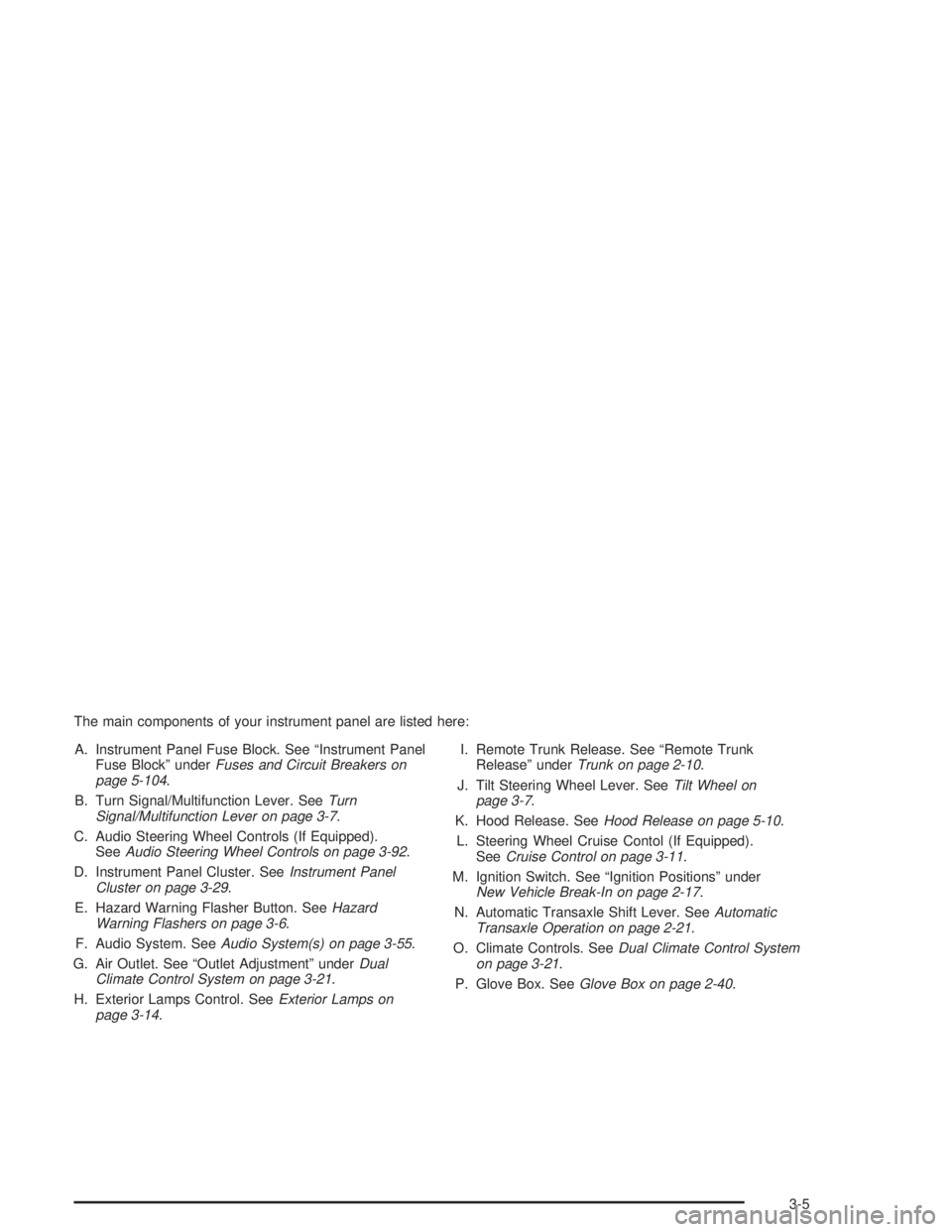
The main components of your instrument panel are listed here:
A. Instrument Panel Fuse Block. See “Instrument Panel
Fuse Block” underFuses and Circuit Breakers on
page 5-104.
B. Turn Signal/Multifunction Lever. SeeTurn
Signal/Multifunction Lever on page 3-7.
C. Audio Steering Wheel Controls (If Equipped).
SeeAudio Steering Wheel Controls on page 3-92.
D. Instrument Panel Cluster. SeeInstrument Panel
Cluster on page 3-29.
E. Hazard Warning Flasher Button. SeeHazard
Warning Flashers on page 3-6.
F. Audio System. SeeAudio System(s) on page 3-55.
G. Air Outlet. See “Outlet Adjustment” underDual
Climate Control System on page 3-21.
H. Exterior Lamps Control. SeeExterior Lamps on
page 3-14.I. Remote Trunk Release. See “Remote Trunk
Release” underTrunk on page 2-10.
J. Tilt Steering Wheel Lever. SeeTilt Wheel on
page 3-7.
K. Hood Release. SeeHood Release on page 5-10.
L. Steering Wheel Cruise Contol (If Equipped).
SeeCruise Control on page 3-11.
M. Ignition Switch. See “Ignition Positions” under
New Vehicle Break-In on page 2-17.
N. Automatic Transaxle Shift Lever. SeeAutomatic
Transaxle Operation on page 2-21.
O. Climate Controls. SeeDual Climate Control System
on page 3-21.
P. Glove Box. SeeGlove Box on page 2-40.
3-5
Page 122 of 416
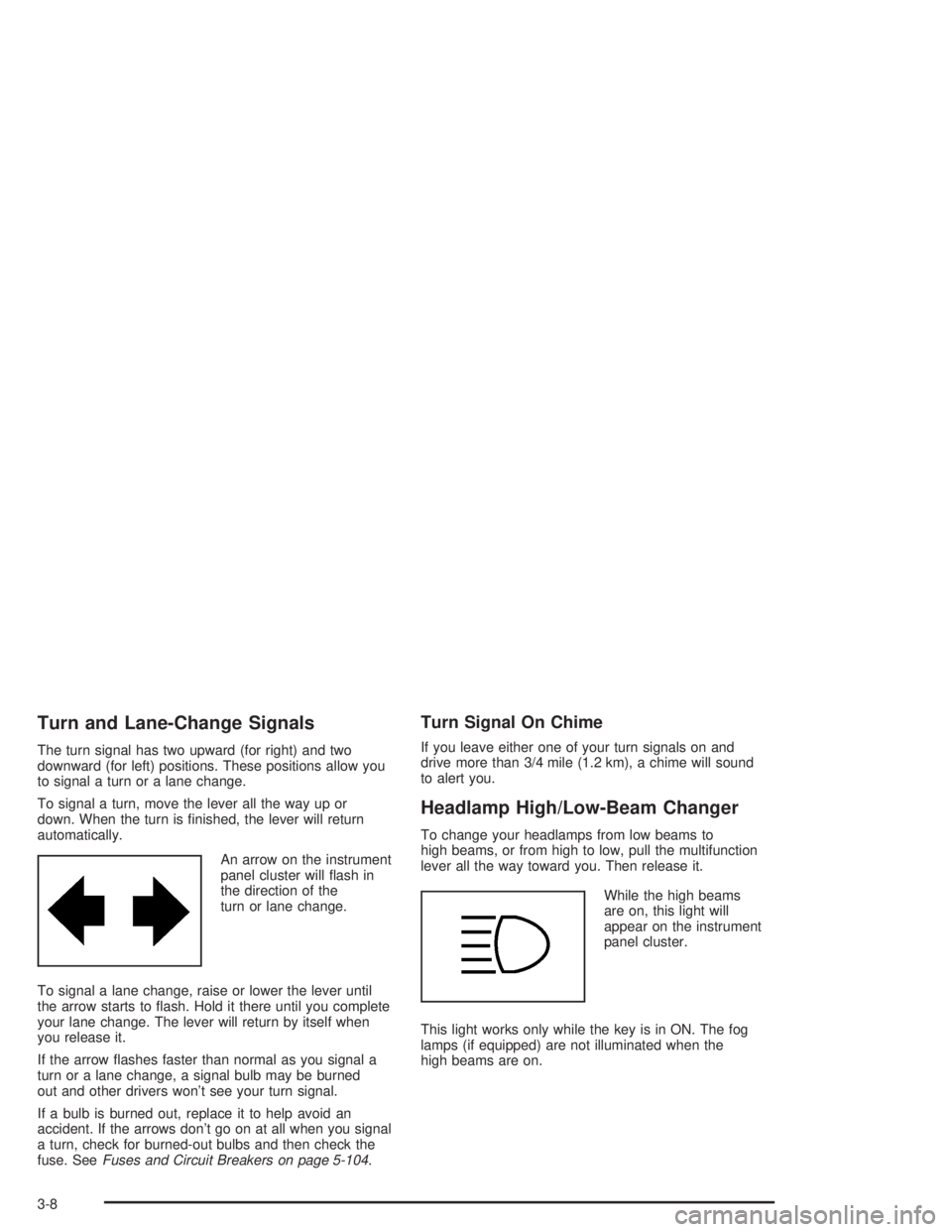
Turn and Lane-Change Signals
The turn signal has two upward (for right) and two
downward (for left) positions. These positions allow you
to signal a turn or a lane change.
To signal a turn, move the lever all the way up or
down. When the turn is �nished, the lever will return
automatically.
An arrow on the instrument
panel cluster will �ash in
the direction of the
turn or lane change.
To signal a lane change, raise or lower the lever until
the arrow starts to �ash. Hold it there until you complete
your lane change. The lever will return by itself when
you release it.
If the arrow �ashes faster than normal as you signal a
turn or a lane change, a signal bulb may be burned
out and other drivers won’t see your turn signal.
If a bulb is burned out, replace it to help avoid an
accident. If the arrows don’t go on at all when you signal
a turn, check for burned-out bulbs and then check the
fuse. SeeFuses and Circuit Breakers on page 5-104.
Turn Signal On Chime
If you leave either one of your turn signals on and
drive more than 3/4 mile (1.2 km), a chime will sound
to alert you.
Headlamp High/Low-Beam Changer
To change your headlamps from low beams to
high beams, or from high to low, pull the multifunction
lever all the way toward you. Then release it.
While the high beams
are on, this light will
appear on the instrument
panel cluster.
This light works only while the key is in ON. The fog
lamps (if equipped) are not illuminated when the
high beams are on.
3-8
Page 134 of 416
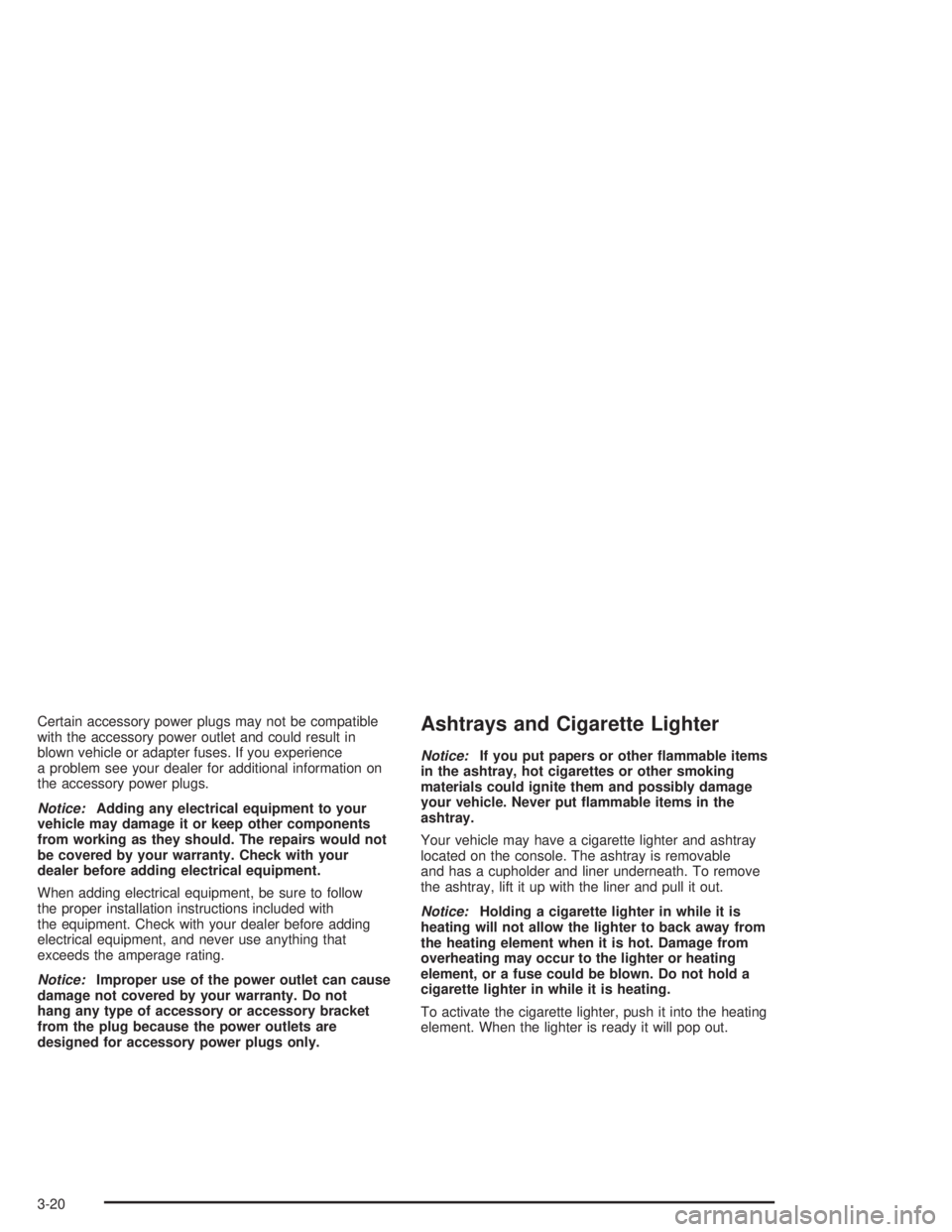
Certain accessory power plugs may not be compatible
with the accessory power outlet and could result in
blown vehicle or adapter fuses. If you experience
a problem see your dealer for additional information on
the accessory power plugs.
Notice:Adding any electrical equipment to your
vehicle may damage it or keep other components
from working as they should. The repairs would not
be covered by your warranty. Check with your
dealer before adding electrical equipment.
When adding electrical equipment, be sure to follow
the proper installation instructions included with
the equipment. Check with your dealer before adding
electrical equipment, and never use anything that
exceeds the amperage rating.
Notice:Improper use of the power outlet can cause
damage not covered by your warranty. Do not
hang any type of accessory or accessory bracket
from the plug because the power outlets are
designed for accessory power plugs only.Ashtrays and Cigarette Lighter
Notice:If you put papers or other �ammable items
in the ashtray, hot cigarettes or other smoking
materials could ignite them and possibly damage
your vehicle. Never put �ammable items in the
ashtray.
Your vehicle may have a cigarette lighter and ashtray
located on the console. The ashtray is removable
and has a cupholder and liner underneath. To remove
the ashtray, lift it up with the liner and pull it out.
Notice:Holding a cigarette lighter in while it is
heating will not allow the lighter to back away from
the heating element when it is hot. Damage from
overheating may occur to the lighter or heating
element, or a fuse could be blown. Do not hold a
cigarette lighter in while it is heating.
To activate the cigarette lighter, push it into the heating
element. When the lighter is ready it will pop out.
3-20
Page 258 of 416
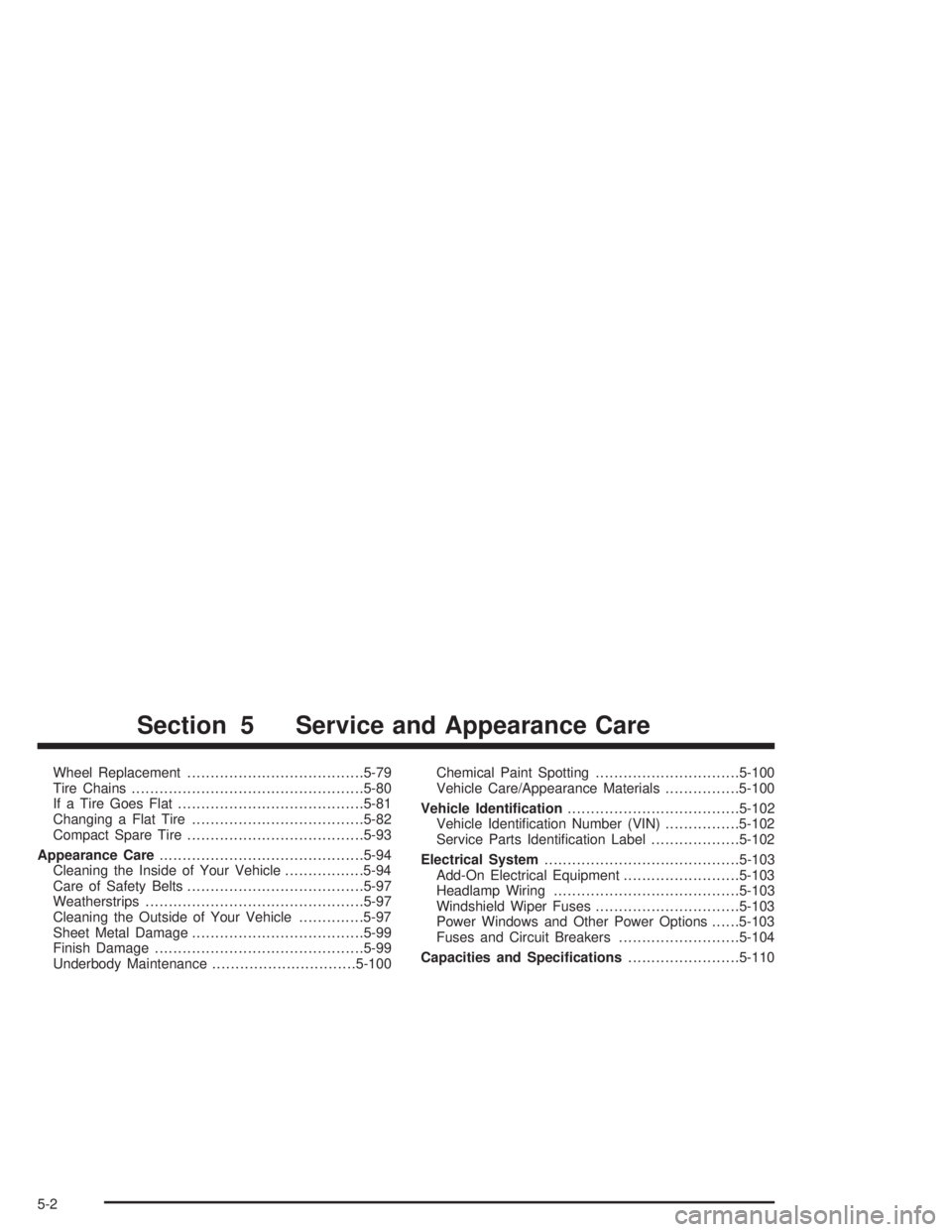
Wheel Replacement......................................5-79
Tire Chains..................................................5-80
If a Tire Goes Flat........................................5-81
Changing a Flat Tire.....................................5-82
Compact Spare Tire......................................5-93
Appearance Care............................................5-94
Cleaning the Inside of Your Vehicle.................5-94
Care of Safety Belts......................................5-97
Weatherstrips...............................................5-97
Cleaning the Outside of Your Vehicle..............5-97
Sheet Metal Damage.....................................5-99
Finish Damage.............................................5-99
Underbody Maintenance...............................5-100Chemical Paint Spotting...............................5-100
Vehicle Care/Appearance Materials................5-100
Vehicle Identi�cation.....................................5-102
Vehicle Identi�cation Number (VIN)................5-102
Service Parts Identi�cation Label...................5-102
Electrical System..........................................5-103
Add-On Electrical Equipment.........................5-103
Headlamp Wiring........................................5-103
Windshield Wiper Fuses...............................5-103
Power Windows and Other Power Options......5-103
Fuses and Circuit Breakers..........................5-104
Capacities and Speci�cations........................5-110
Section 5 Service and Appearance Care
5-2
Page 269 of 416
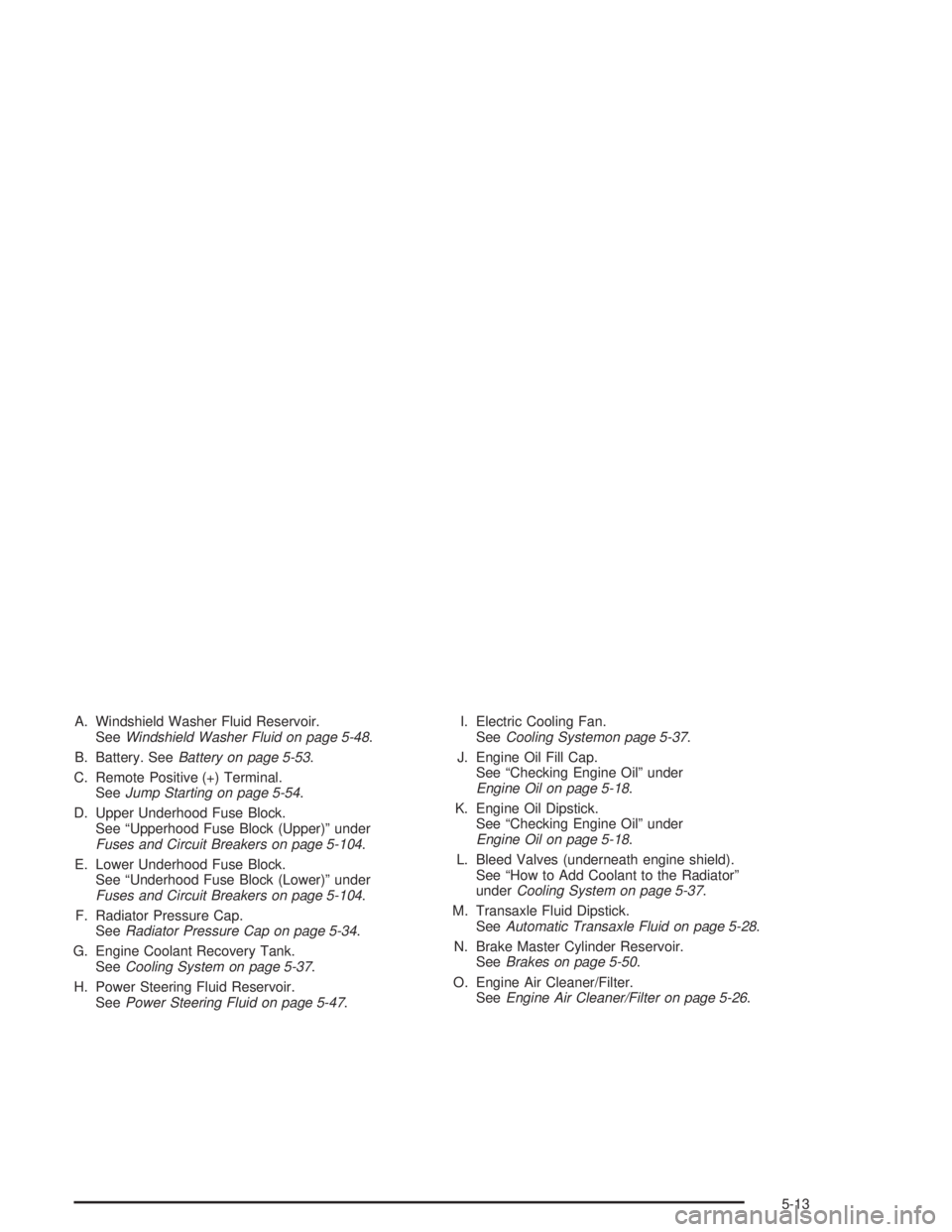
A. Windshield Washer Fluid Reservoir.
SeeWindshield Washer Fluid on page 5-48.
B. Battery. SeeBattery on page 5-53.
C. Remote Positive (+) Terminal.
SeeJump Starting on page 5-54.
D. Upper Underhood Fuse Block.
See “Upperhood Fuse Block (Upper)” under
Fuses and Circuit Breakers on page 5-104.
E. Lower Underhood Fuse Block.
See “Underhood Fuse Block (Lower)” under
Fuses and Circuit Breakers on page 5-104.
F. Radiator Pressure Cap.
SeeRadiator Pressure Cap on page 5-34.
G. Engine Coolant Recovery Tank.
SeeCooling System on page 5-37.
H. Power Steering Fluid Reservoir.
SeePower Steering Fluid on page 5-47.I. Electric Cooling Fan.
SeeCooling Systemon page 5-37.
J. Engine Oil Fill Cap.
See “Checking Engine Oil” under
Engine Oil on page 5-18.
K. Engine Oil Dipstick.
See “Checking Engine Oil” under
Engine Oil on page 5-18.
L. Bleed Valves (underneath engine shield).
See “How to Add Coolant to the Radiator”
underCooling System on page 5-37.
M. Transaxle Fluid Dipstick.
SeeAutomatic Transaxle Fluid on page 5-28.
N. Brake Master Cylinder Reservoir.
SeeBrakes on page 5-50.
O. Engine Air Cleaner/Filter.
SeeEngine Air Cleaner/Filter on page 5-26.
5-13
Page 271 of 416
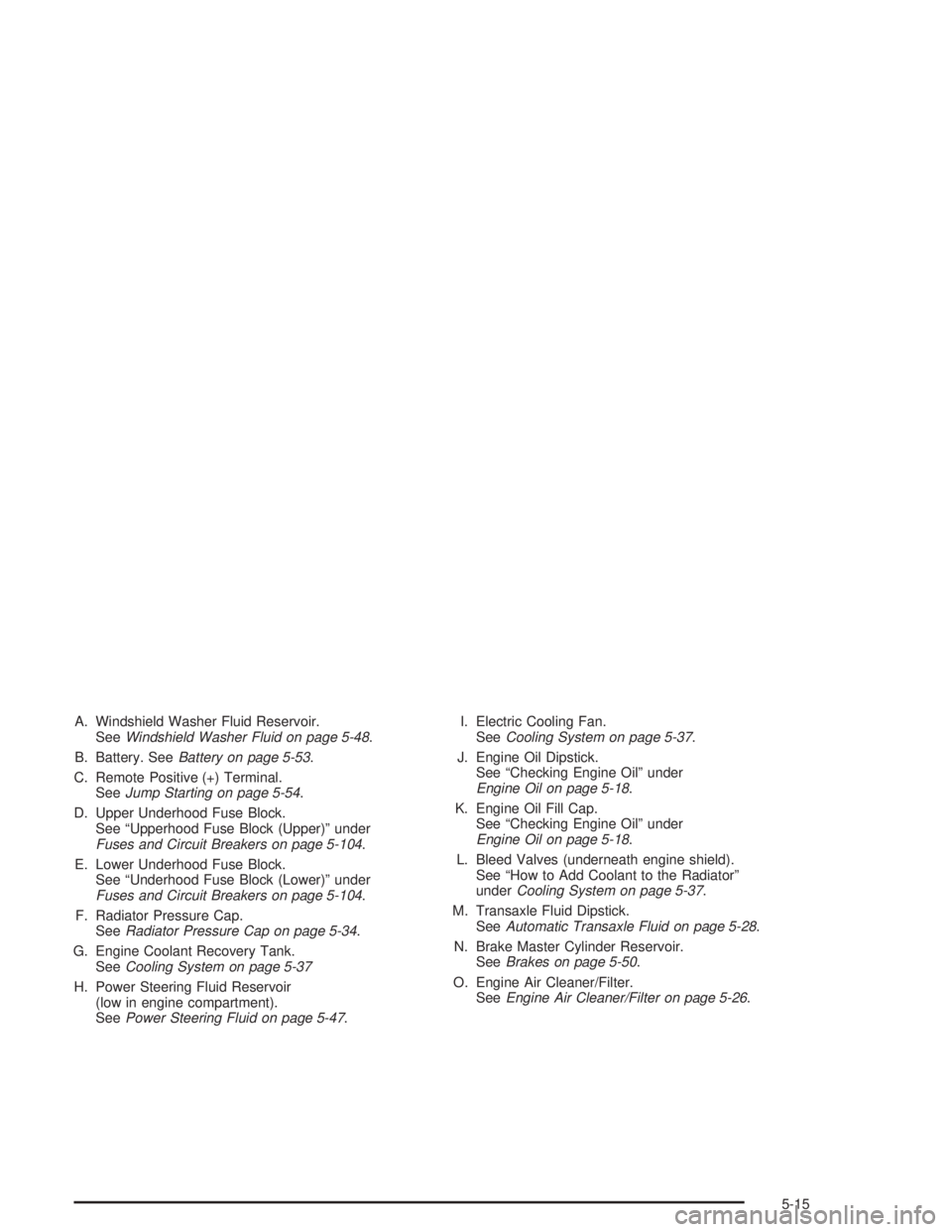
A. Windshield Washer Fluid Reservoir.
SeeWindshield Washer Fluid on page 5-48.
B. Battery. SeeBattery on page 5-53.
C. Remote Positive (+) Terminal.
SeeJump Starting on page 5-54.
D. Upper Underhood Fuse Block.
See “Upperhood Fuse Block (Upper)” under
Fuses and Circuit Breakers on page 5-104.
E. Lower Underhood Fuse Block.
See “Underhood Fuse Block (Lower)” under
Fuses and Circuit Breakers on page 5-104.
F. Radiator Pressure Cap.
SeeRadiator Pressure Cap on page 5-34.
G. Engine Coolant Recovery Tank.
SeeCooling System on page 5-37
H. Power Steering Fluid Reservoir
(low in engine compartment).
SeePower Steering Fluid on page 5-47.I. Electric Cooling Fan.
SeeCooling System on page 5-37.
J. Engine Oil Dipstick.
See “Checking Engine Oil” under
Engine Oil on page 5-18.
K. Engine Oil Fill Cap.
See “Checking Engine Oil” under
Engine Oil on page 5-18.
L. Bleed Valves (underneath engine shield).
See “How to Add Coolant to the Radiator”
underCooling System on page 5-37.
M. Transaxle Fluid Dipstick.
SeeAutomatic Transaxle Fluid on page 5-28.
N. Brake Master Cylinder Reservoir.
SeeBrakes on page 5-50.
O. Engine Air Cleaner/Filter.
SeeEngine Air Cleaner/Filter on page 5-26.
5-15
Page 273 of 416
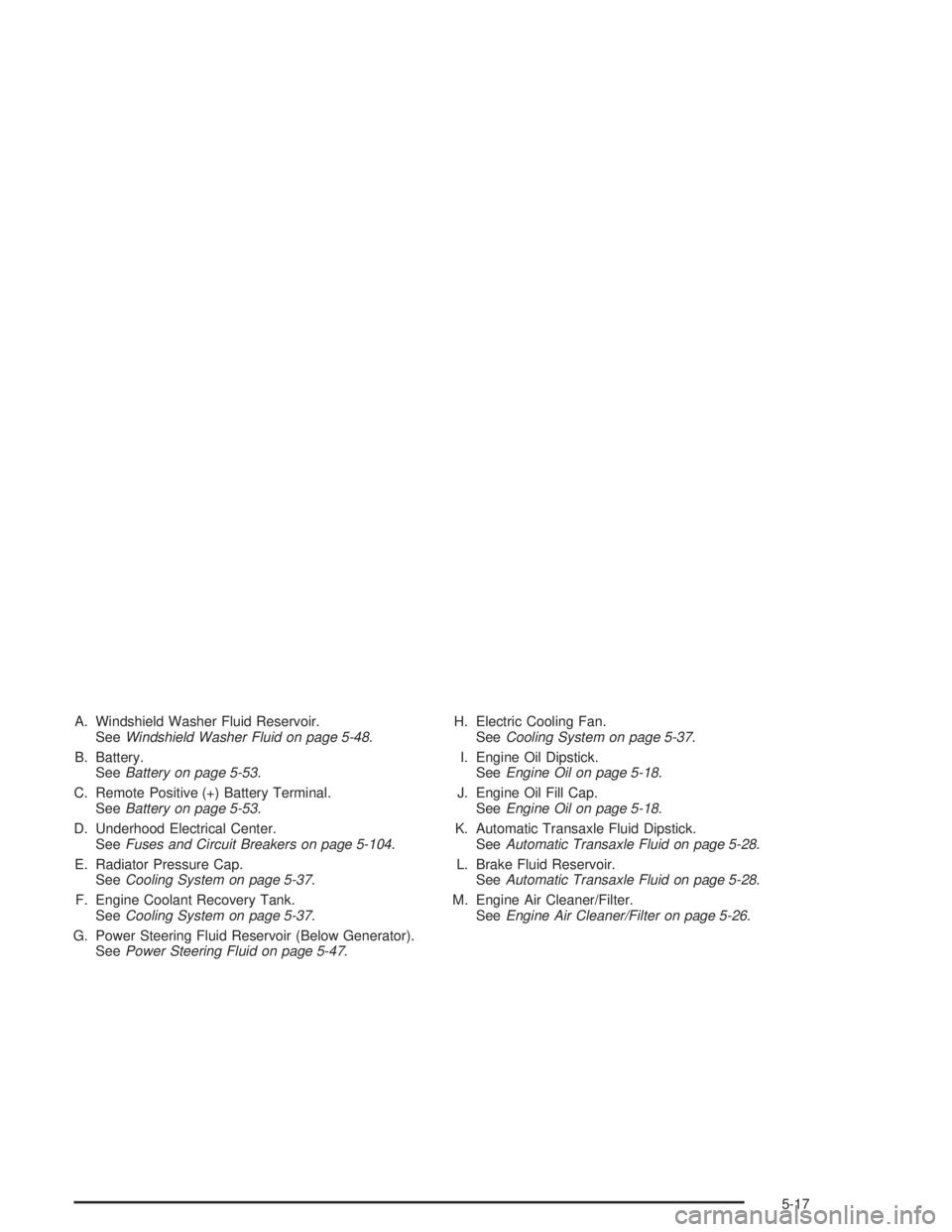
A. Windshield Washer Fluid Reservoir.
SeeWindshield Washer Fluid on page 5-48.
B. Battery.
SeeBattery on page 5-53.
C. Remote Positive (+) Battery Terminal.
SeeBattery on page 5-53.
D. Underhood Electrical Center.
SeeFuses and Circuit Breakers on page 5-104.
E. Radiator Pressure Cap.
SeeCooling System on page 5-37.
F. Engine Coolant Recovery Tank.
SeeCooling System on page 5-37.
G. Power Steering Fluid Reservoir (Below Generator).
SeePower Steering Fluid on page 5-47.H. Electric Cooling Fan.
SeeCooling System on page 5-37.
I. Engine Oil Dipstick.
SeeEngine Oil on page 5-18.
J. Engine Oil Fill Cap.
SeeEngine Oil on page 5-18.
K. Automatic Transaxle Fluid Dipstick.
SeeAutomatic Transaxle Fluid on page 5-28.
L. Brake Fluid Reservoir.
SeeAutomatic Transaxle Fluid on page 5-28.
M. Engine Air Cleaner/Filter.
SeeEngine Air Cleaner/Filter on page 5-26.
5-17
Page 359 of 416
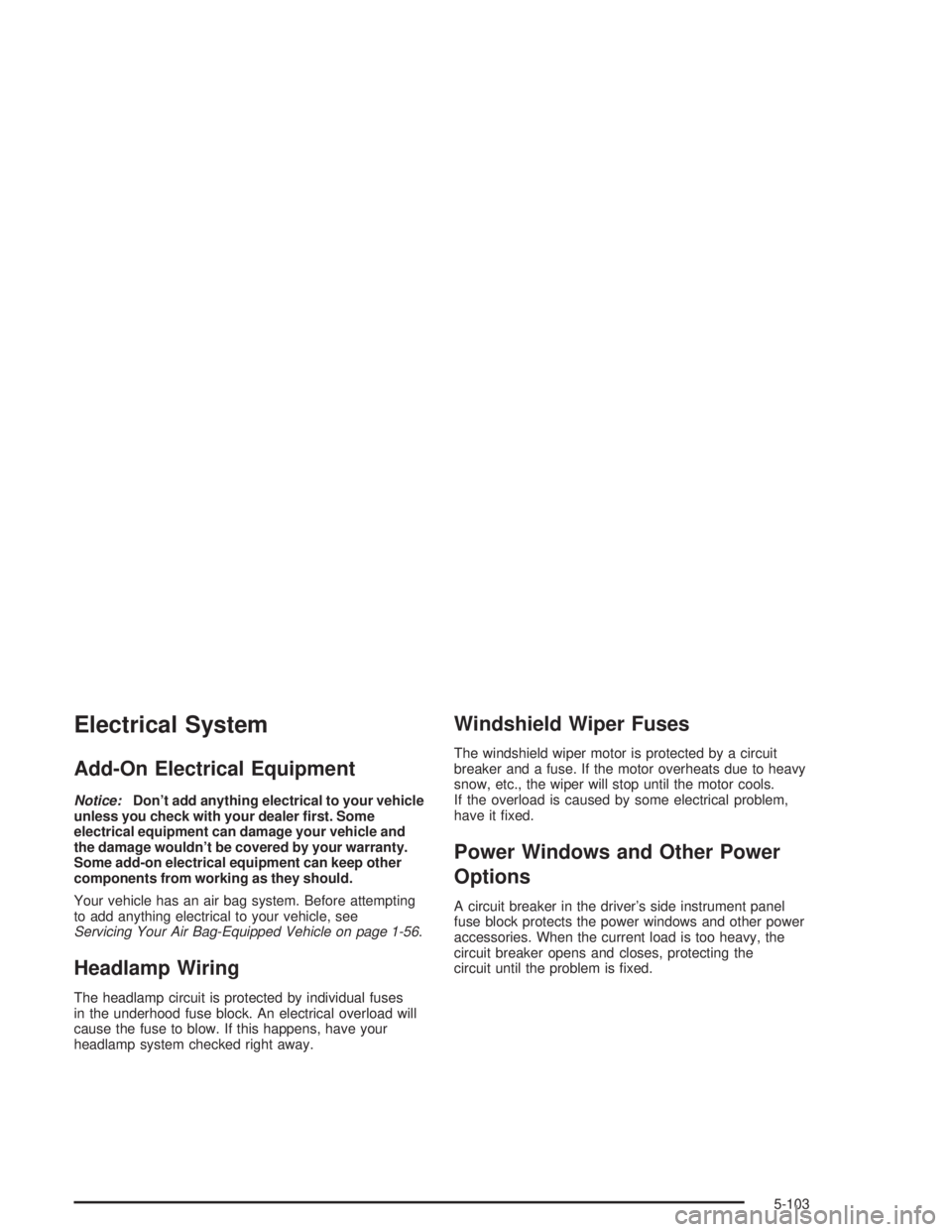
Electrical System
Add-On Electrical Equipment
Notice:Don’t add anything electrical to your vehicle
unless you check with your dealer �rst. Some
electrical equipment can damage your vehicle and
the damage wouldn’t be covered by your warranty.
Some add-on electrical equipment can keep other
components from working as they should.
Your vehicle has an air bag system. Before attempting
to add anything electrical to your vehicle, see
Servicing Your Air Bag-Equipped Vehicle on page 1-56.
Headlamp Wiring
The headlamp circuit is protected by individual fuses
in the underhood fuse block. An electrical overload will
cause the fuse to blow. If this happens, have your
headlamp system checked right away.
Windshield Wiper Fuses
The windshield wiper motor is protected by a circuit
breaker and a fuse. If the motor overheats due to heavy
snow, etc., the wiper will stop until the motor cools.
If the overload is caused by some electrical problem,
have it �xed.
Power Windows and Other Power
Options
A circuit breaker in the driver’s side instrument panel
fuse block protects the power windows and other power
accessories. When the current load is too heavy, the
circuit breaker opens and closes, protecting the
circuit until the problem is �xed.
5-103
Page 360 of 416
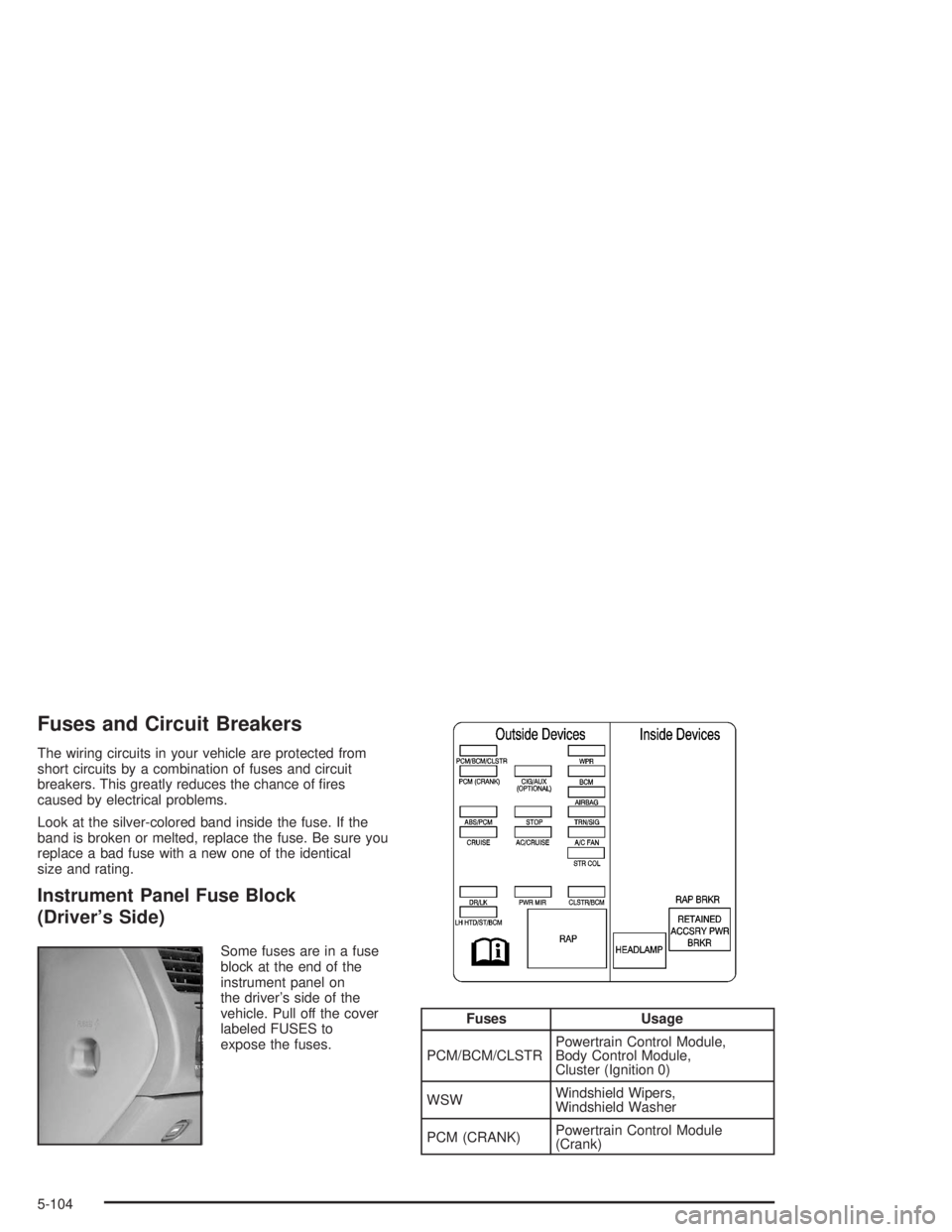
Fuses and Circuit Breakers
The wiring circuits in your vehicle are protected from
short circuits by a combination of fuses and circuit
breakers. This greatly reduces the chance of �res
caused by electrical problems.
Look at the silver-colored band inside the fuse. If the
band is broken or melted, replace the fuse. Be sure you
replace a bad fuse with a new one of the identical
size and rating.
Instrument Panel Fuse Block
(Driver’s Side)
Some fuses are in a fuse
block at the end of the
instrument panel on
the driver’s side of the
vehicle. Pull off the cover
labeled FUSES to
expose the fuses.
Fuses Usage
PCM/BCM/CLSTRPowertrain Control Module,
Body Control Module,
Cluster (Ignition 0)
WSWWindshield Wipers,
Windshield Washer
PCM (CRANK)Powertrain Control Module
(Crank)
5-104